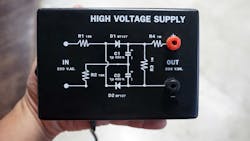How to Overcome the Limits of Boost Converters (Download)
Boost converters are used to generate high output voltages from low input voltages. Such a voltage conversion can easily be done with a switching regulator that has a boost topology. However, the voltage gain has a natural limit: The voltage gain is the ratio of output voltage to input voltage. If 24 V is generated from 12 V, then the voltage gain is 2.
As an example, let’s look at an industrial application in which a voltage of 300 V should be generated with a 160-mA output current from a 24-V supply voltage.
